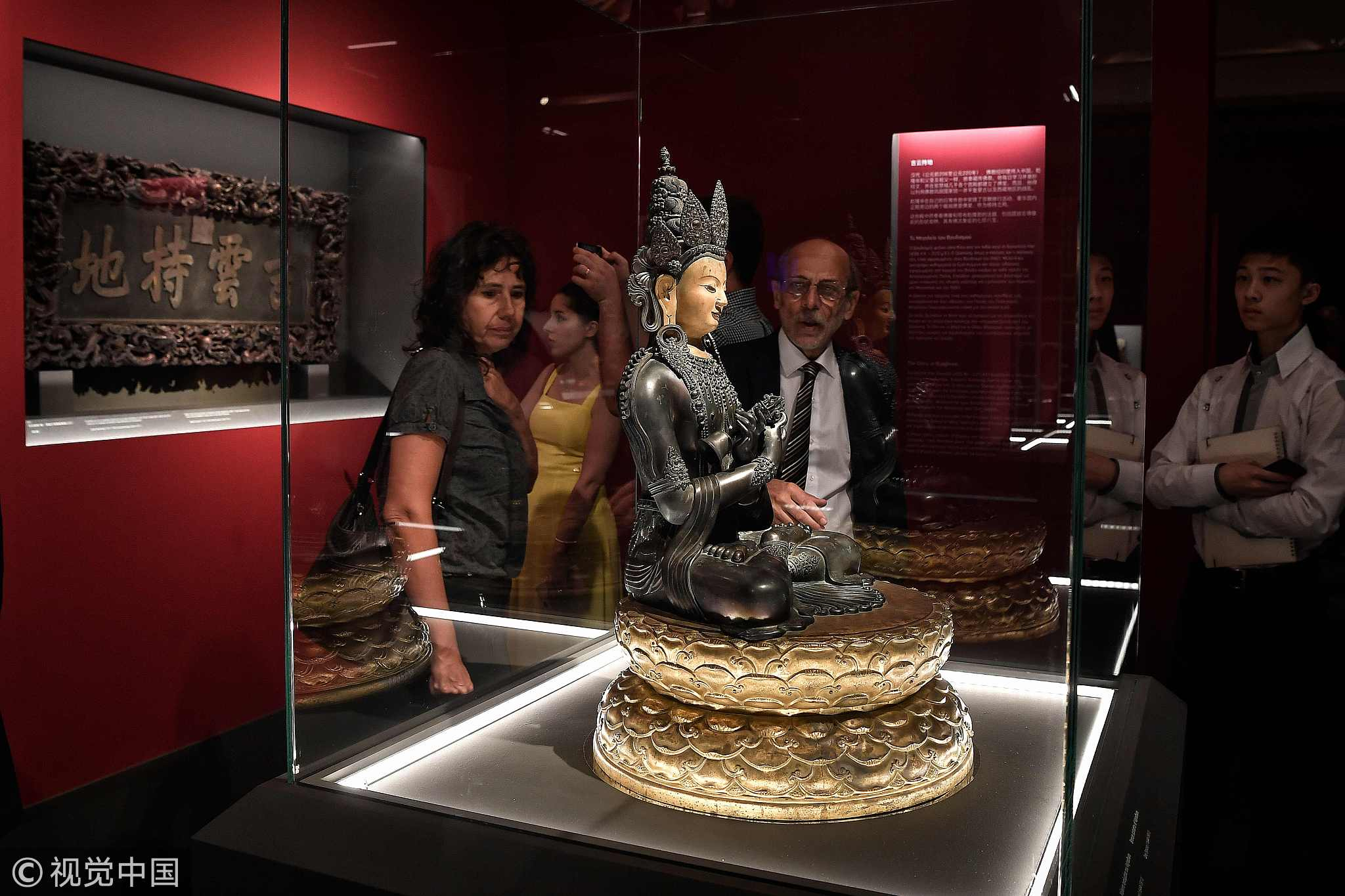An unprecedented exhibition is taking place at the Acropolis Museum, presenting artifacts from Chinese Emperor Qianlong (1711-1799) during the Qing Dynasty, said the museum's director.
"People are very excited about what they have seen here. I think it is very important for Greek audiences to have for the first time a real view of China's history and a person who was an excellent ruler and artist, something unusual for leaders," Dimitrios Pandermalis told Xinhua News Agency.
The temporary exhibition, "From the Forbidden City: imperial apartments of Qianlong," was inaugurated in September in partnership with Beijing's Palace Museum. It will be on display until February 14 next year, in the context of cultural exchanges between Greece and China.
Pandermalis sees the collaboration between the Acropolis Museum and Palace Museum as excellent and fruitful, adding that such synergies bring the two cultures closer and broaden Sino-Greek relations.
Last week, 12 important artworks were withdrawn due to the fragility of the materials from which they are made and were replaced by 12 other works.

A visitor looks at the Emperor's wife's Room of Fragrant Orchids, during the official opening of the Acropolis Museum's rare temporary exhibition “From the Forbidden City: imperial apartments of Qianlong” in Athens, September 14, 2018. /VCG Photo
A visitor looks at the Emperor's wife's Room of Fragrant Orchids, during the official opening of the Acropolis Museum's rare temporary exhibition “From the Forbidden City: imperial apartments of Qianlong” in Athens, September 14, 2018. /VCG Photo
"This was necessary due to conservation reasons. We changed mainly the ceremonial robes, the costumes of the actors and some other minor objects. I think this gives another flavor," Pandermalis noted.
Among the key objects replaced was the huge portrait of Emperor Qianlong as a young man at the entrance of the exhibition. The new painting gives an elderly rendition of the emperor, with wisdom radiating from his demeanor.
Drawing inspiration directly from the palaces of the Forbidden City, visitors can travel through time to the Palace of Many Splendors (Chonghua Gong), the palace where the emperor used to live when he was an imperial prince, to admire the bedroom with the decoration of golden flowers, the Emperor's study desk made of red sandalwood and the statues that reveal his devoted practice of Tibetan Buddhism.
"The visitors can have the first impression of the symbolic objects and the environment of the Chinese tradition," Pandermalis said.

Visitors look at the bronze statuette of Vajradhara, Qing Dynasty, Qianlong Reign (1735–1796), during the official opening of the Acropolis Museum's rare temporary exhibition “From the Forbidden City: imperial apartments of Qianlong” in Athens, September 14, 2018. /VCG Photo
Visitors look at the bronze statuette of Vajradhara, Qing Dynasty, Qianlong Reign (1735–1796), during the official opening of the Acropolis Museum's rare temporary exhibition “From the Forbidden City: imperial apartments of Qianlong” in Athens, September 14, 2018. /VCG Photo
Pandermalis says that the exhibition showcases not only China's history but also the Emperor's contribution to the Qing Dynasty, which reached its zenith during his reign.
"He was an Emperor during the European Enlightenment. He created a parallel movement in China in a special style. I think he reorganized the whole country, he enlarged the empire of China, and in his time China was the largest and one of the wealthiest countries on the globe," he noted.
It is not the first time the Acropolis Museum has collaborated with a Chinese museum. As a first step of the cultural exchange, the museum partnered with the Shanghai Museum last year with small-scale exhibitions and art workshops.
Pandermalis believes that the dialogue between the two cultures can continue after the end of this exhibition. To enhance the cooperation of the two museums, he suggested that both sides share their experience in other fields of expertise.

A visitor looks at exhibits from the private apartments of 18th-century Emperor Qianlong, one of the most renowned rulers in Chinese history, during the official opening of the Acropolis Museum's rare temporary exhibition “From the Forbidden City: imperial apartments of Qianlong” in Athens, September 14, 2018. /VCG Photo
A visitor looks at exhibits from the private apartments of 18th-century Emperor Qianlong, one of the most renowned rulers in Chinese history, during the official opening of the Acropolis Museum's rare temporary exhibition “From the Forbidden City: imperial apartments of Qianlong” in Athens, September 14, 2018. /VCG Photo
"I think a chapter very interesting is conservation. You do a lot in China; we do the same here. We can exchange experience," Pandermalis said.
Pandermalis considers the Sino-Greek cultural approach very beneficial, as it contributed to a better understanding between the two peoples through the presentation of the objects.
The president admitted that the ongoing temporary exhibition has broadened his horizon as he read many texts on Chinese history and philosophy for the preparation of the curatorial, which in turn helped him understand Chinese culture better.
(Top image: A visitor looks at a ceremonial robe of China's 18th-century Emperor Qianlong, one of the most renowned rulers in Chinese history, during the official opening of the Acropolis Museum's rare temporary exhibition “From the Forbidden City: imperial apartments of Qianlong” in Athens, September 14, 2018. /VCG Photo)
Source(s): Xinhua News Agency





